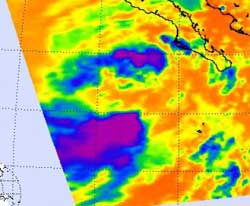NASA sees the short life of Tropical Depression John

NASA's Aqua satellite flew over John on Sept. 3 at 2041 UTC (4:41 p.m. EDT) during its brief time as a tropical storm and noticed the strongest convection (purple) and coldest cloud top temperatures seemed to be limited to the northeastern and southwestern quadrants of the storm.<br><br>Credit: NASA JPL, Ed Olsen<br>
NASA's Aqua satellite flew over John on Sept. 3 at 2041 UTC (4:41 p.m. EDT) during its brief time as a tropical storm and noticed convection (rising air that forms thunderstorms that make up the storm) and coldest cloud top temperatures seemed to be limited to the northeastern and southwestern quadrants of the storm. As John continued to move north into cooler waters the convection tapered off, and the development of strong thunderstorms diminished.
By Tuesday, September 04, 2012 at 2 a.m. EDT, there was no sign of strong convection in John and the storm had become “a swirl of low- to mid-level clouds,” according to the National Hurricane Center.
At 11 a.m. EDT today, Tropical Depression John's maximum sustained winds were near 35 mph (55 kmh) and the storm is weakening. It was centered about 420 miles (620 km) west of the southernmost tip of Baja California, near 23.5 North and 116.5 West. John was moving to the northwest near 14 mph (22 kmh) and is expected to keep moving in that general direction while slowing over the cooler waters.
John's fame is fleeting as the tropical depression is expected to become a remnant area of low pressure later today, Sept. 4.
Media Contact
More Information:
http://www.nasa.govAll latest news from the category: Earth Sciences
Earth Sciences (also referred to as Geosciences), which deals with basic issues surrounding our planet, plays a vital role in the area of energy and raw materials supply.
Earth Sciences comprises subjects such as geology, geography, geological informatics, paleontology, mineralogy, petrography, crystallography, geophysics, geodesy, glaciology, cartography, photogrammetry, meteorology and seismology, early-warning systems, earthquake research and polar research.
Newest articles

Properties of new materials for microchips
… can now be measured well. Reseachers of Delft University of Technology demonstrated measuring performance properties of ultrathin silicon membranes. Making ever smaller and more powerful chips requires new ultrathin…

Floating solar’s potential
… to support sustainable development by addressing climate, water, and energy goals holistically. A new study published this week in Nature Energy raises the potential for floating solar photovoltaics (FPV)…

Skyrmions move at record speeds
… a step towards the computing of the future. An international research team led by scientists from the CNRS1 has discovered that the magnetic nanobubbles2 known as skyrmions can be…




















